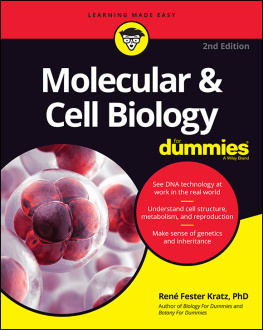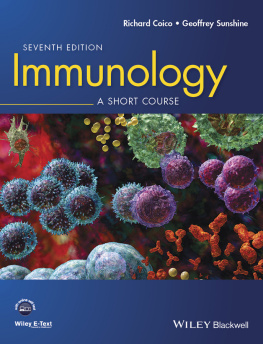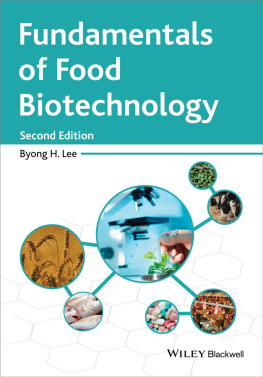ABOUT THE AUTHOR
Sharon Walker, Ph.D, is a Diplomat of the American Board of Toxicology (DABT) and has done extensive research in various areas of biomedicine. Dr. Walker has many years' experience as a safety analyst for high hazard operations, and has taught graduate courses in immunology, epidemiology, cell biology, and statistics.
ACKNOWLEDGMENTS
I gratefully acknowledge the substantial contribution of Bret Wing, who provided a thorough and thoughtful review of this book. I would also like to thank David McMahon who gave invaluable guidance during the development of this book. Finally, many thanks to Lee, Brad, and Lindsey for their encouragment, and to my Uncle Ed and Aunt Sarah for their support.
Answers to Quiz and
Exam Questions
.
Chapter 1: Biomolecules and Energy
1. d
2. f
3. f
4. g
5. b
6. e
7. e
8. a
9. e
10. g
Chapter 2: Cell Structures and Cell Division
1. b
2. d
3. e
4. b
5. f
6. e
7. a
8. e
9. e
10. f
Chapter 3: Information Methods of a Cell
1. c
2. c
3. a
4. e
5. e
6. c
7. e
8. d
9. a
10. e
Chapter 4: Genetics
1. a
2. b
3. d
4. b
5. c
6. d
7. e
8. f
9. b
10. b
Chapter 5: Immunology
1. e
2. b
3. e
4. d
5. c
6. b
7. c
8. d
9. f
10. d
Chapter 6: Immunotherapy and Other Bioengineering Applications
1. d
2. b
3. c
4. f
5. f
6. e
7. d
8. a
9. e
10. d
Chapter 7: Recombinant Techniques and Deciphering DNA
1. b
2. e
3. e
4. e
5. c
6. f
7. e
8. e
9. f
10. c
Chapter 8: Proteomics
1. e
2. a
3. e
4. d
5. e
6. f
7. c
8. d
9. d
10. d
Chapter 9: Stem Cells
1. f
2. b
3. f
4. g
5. b
6. g
7. d
8. e
9. d
10. e
Chapter 10: Medical Applications
1. a
2. e
3. c
4. e
5. c
6. d
7. e
8. f
9. b
10. f
Chapter 11: Agricultural Applications
1. e
2. c
3. e
4. f
5. b
6. e
7. e
8. c
9. e
10. b
Chapter 12: Industrial and Environmental Applications
1. e
2. d
3. e
4. d
5. f
6. e
7. c
8. b
9. d
10. e
Chapter 13: The Future
1. e
2. c
3. c
4. e
5. c
6. e
7. c
8. e
9. b
10. b
Final Exam
1. c
2. f
3. f
4. d
5. d
6. c
7. g
8. f
9. d
10. d
11. e
12. f
13. g
14. b
15. c
16. f
17. c
18. e
19. f
20. f
21. b
22. c
23. d
24. b
25. f
26. c
27. d
28. f
29. a
30. c
31. d
32. d
33. a
34. a
35. e
36. c
37. b
38. c
39. e
40. e
41. c
42. c
43. b
44. e
45. a
46. b
47. e
48. e
49. c
50. e
51. e
52. e
53. d
54. f
55. a
56. b
57. d
58. d
59. e
60. f
61. e
62. a
63. b
64. c
65. g
66. d
67. e
68. b
69. f
70. f
71. d
72. c
73. e
74. b
75. e
76. b
77. d
78. c
79. b
80. d
81. b
82. h
83. d
84. b
85. e
86. e
87. f
88. c
89. b
90. b
91. d
92. a
93. a
94. f
95. f
96. a
97. d
98. e
99. g
100. b
101. c
CHAPTER 1
Biomolecules and Energy
.
As a bioengineer, you will be using the systems, subsystems, and molecular units devised by nature towards your own ends. Of course, the more you understand about the natural way of things, the more effective you will be in using and modifying nature. One of the huge benefits reaped from the recent mushrooming of biotechnology initiatives is an unprecedented leap in the knowledge of cellular systems. Before we discuss the recent advances in our knowledge, let's review the basics.
Before you can begin, you must have some knowledge of what you have to work with. First, we need to do a quick review of molecular forces and then we'll describe the building blocks for constructing the most complex of all systemsa living organism.
Review of Molecular Forces
You will need a basic knowledge of how molecules interact to understand how cells function. We don't need to delve into chemistry very far, but you should understand how atoms stick together to form molecules. Biomolecules (molecules in biological systems) abide by the same physical laws as any other physical structure.
There are two ways that atoms can associate with one another to form molecules, through ionic or covalent bonds. To understand this review, you need to know that positively-charged protons exist in the nucleus of an atom, together with neutral neutrons. The negatively-charged electrons travel in shells around the nucleus. Atoms have the same number of electrons as protons, so the atom is neutrally charged. Simple enough.
For the discussion of the electron shells, envision the shells as a series of shelves that must be filled in a certain order. Each shell can accommodate a specific number of electrons. Hydrogen, for example, has one electron in the first shell that existsthe shell with the lowest possible energy state. (Nature seeks the lowest energy state available.) There is one electron because hydrogen has only one proton and the number of electrons in an atom equals the number of protons. The first shell needs to have two electrons before it is full; yes, it wants one more electron than it has protons. So, hydrogen will react easily with other molecules that want to give up an electron. Contrast the behavior of hydrogen with that of helium. Helium has two electrons. The electron shell is perfectly happy, and helium will not react with anything.
When the first shell is full, the next shell, with a higher energy level, receives the additional electrons. The next element is lithium, which has three protons and three electrons. The first shell has two electrons and is stable. However, that third electron in the outer shell wants a buddy badly, so lithium is highly reactive and will give up the third electron at the drop of a hat.
Let's use hydrogen and lithium to explain the difference between ionic and covalent bonds. Ionic bonds, shown in , are formed when one atom gives up an electron to another atom. Lithium will donate its extra third electron to another atom that is short a full house, such as chlorine. When this reaction occurs, lithium assumes a positive charge because the atom has lost the negatively-charged electron, and chlorine receives a negative charge by picking up one more electron that it has positively-charged protons. If this reaction occurs while these atoms are in solution, the positively-charged and the negatively-charge chlorine will float around independently of one another. If you keep adding lithium and chlorine, eventually there are so many atoms that the water cannot keep them apart. The opposite charges will cause these atoms to associate with one another and form lithium chloride salt. The lithium chloride salt is a molecule; however, the forces keeping these two atoms together are not strong and can be easily disrupted by adding more water. And an atom or molecule with a stronger charge can definitely compete for one of the





